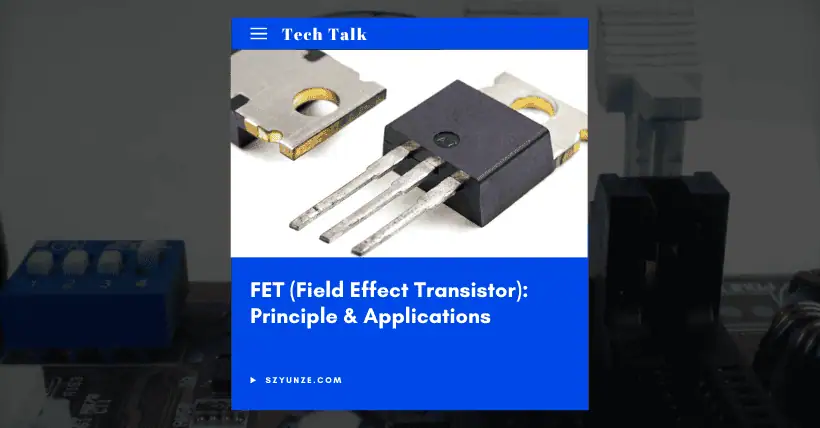1. What is a Field Effect Transistor?
To understand the “field-effect transistor,” we first need to understand what the “field” and “field effect” refer to. Additionally, some basic knowledge is necessary.
In simple terms, the “field” here refers to an electric field, and the “field effect” refers to the effect of the electric field. So, what is the electric field effect? It refers to the phenomenon where the electrical, optical, mechanical, and other properties of a material change under the influence of an electric field.
2. Basic Knowledge
An electric field is a special substance that exists in the space surrounding electric charges and changing magnetic fields. When an electric field is applied around an object or material, it affects the charge distribution inside the object.
For conductors, the electric field causes free electrons to move in a directed manner, creating an electric current. In semiconductors, the electric field can alter the distribution and movement of charge carriers (electrons and holes), thereby controlling the conductivity of the semiconductor. For insulators, although there are almost no free-moving charges inside, the electric field may still cause slight changes in the charge distribution of atoms or molecules, resulting in polarization.
3. Common Electric Field Effects
Common electric field effects include the following:
- Field emission: In a strong electric field, electrons escape from the surface of metals or semiconductors.
- Electro-optic effect: Certain crystals change their optical properties (such as refractive index and light transmission) when subjected to an electric field.
- Piezoelectric effect: Some crystalline materials generate charge when subjected to mechanical stress, or undergo mechanical deformation when subjected to an electric field. The former is called the direct piezoelectric effect, and the latter is called the inverse piezoelectric effect.
4. Working Principle of the Field Effect Transistor
The field-effect transistor operates based on the electric field effect. It controls the current in the semiconductor channel by changing the gate voltage. Unlike bipolar junction transistors, which use both electrons and holes as charge carriers, the field-effect transistor uses only one type of carrier, thus it is also known as a unipolar transistor.
Taking the most common metal-oxide-semiconductor field-effect transistor (MOSFET) as an example, its structure includes the source, drain, and gate. When a certain voltage is applied between the gate and the source, a conductive channel is formed on the semiconductor surface, allowing current to flow between the source and drain. By changing the gate voltage, the width and conductivity of the channel change, which precisely controls the current between the source and drain.
5. Application Fields of Field-Effect Transistors
✅ Consumer Electronics
In the field of consumer electronics, field-effect transistors are key to achieving device miniaturization and high performance. In smartphones, processors, memory chips, and power management chips extensively use MOSFETs. These transistors not only reduce power consumption and extend battery life but also improve device speed, providing users with a smoother experience.
✅ Automotive Electronics
With the development of electric and intelligent vehicles, field-effect transistors are increasingly applied in automotive electronics. In electric vehicle drive systems, IGBTs act as power switching devices to control motor speed and torque, and their performance directly affects the vehicle’s range, acceleration, and safety.
Meanwhile, MOSFETs are also widely used in automotive power management, lighting systems, in-car entertainment systems, etc., helping vehicles achieve more efficient energy management and richer functional configurations.
✅ Industrial Control
In the field of industrial control, field-effect transistors are widely used in equipment such as motor control, variable frequency drives, and power conversion. Due to their high voltage tolerance and large current handling capabilities, IGBTs have become the preferred device for industrial motor drives, enabling precise speed regulation and efficient operation of motors. MOSFETs also play an important role in industrial power supplies, efficiently converting electrical energy through high-frequency switching, reducing the size and weight of the power supply, and improving system reliability.
6. Summary
In general, the field-effect transistor is a semiconductor device that controls its conductivity through an electric field. It mainly uses the adjustment or change of the gate voltage to control whether the current flows between the source and drain and to control the current magnitude.
Field-effect transistors have made significant progress over the years. Their performance is continuously improving, and their application fields are expanding. In the future, with continuous technological innovation, field-effect transistors will continue to evolve, playing an even greater role.
Related:

Disclaimer:
- This channel does not make any representations or warranties regarding the availability, accuracy, timeliness, effectiveness, or completeness of any information posted. It hereby disclaims any liability or consequences arising from the use of the information.
- This channel is non-commercial and non-profit. The re-posted content does not signify endorsement of its views or responsibility for its authenticity. It does not intend to constitute any other guidance. This channel is not liable for any inaccuracies or errors in the re-posted or published information, directly or indirectly.
- Some data, materials, text, images, etc., used in this channel are sourced from the internet, and all reposts are duly credited to their sources. If you discover any work that infringes on your intellectual property rights or personal legal interests, please contact us, and we will promptly modify or remove it.



